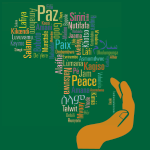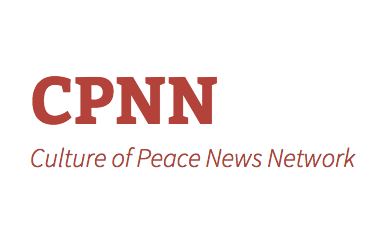International Day of Peace
According to our survey of the Internet there was a great increase in participation in the International Day of Peace this year. This was true in all regions of the world except for Ukraine and Russian Federation.
Of course, Ukraine and Russian Federation are a special case since they are at war. Despite this, there were 61 events from Ukraine and 45 from the Russian Federation, which is especially remarkable since, according to UNICEF, half of the children of Ukraine are out of school because of the war. Most of the events involved school children. On both sides of the war, they drew or cut out paper doves and wrote their wishes for peace on them. Often they sent them into the sky on balloons. Their actions were especially heart-wrenching this year. Has there ever been such a time when the children on both sides of a war could express and publish for the world to see their wishes for peace?
Elsewhere in Europe we found reference to actions in 293 communities, over 100 more than last year. As in previous years, the greatest number was recorded in Belgium where 136 towns and municipalities participated in a campaign to fly the peace flag on official buildings. The Collective for 21 September coordinated and described actions in more than half of the one hundred departments of France, including marches and demonstrations, often linked to the struggle to preserve the planet from global warming.
In Spain, several cities, including Navarra and Tolosa celebrated the day with the premiere of a work called “Zotoz” for female choirs. The choral performances were filmed in beautiful historic sites and made available on the Internet. In Italy, the national post office issued a special colorful postcard for the day which was available throughout the country. Also at a national level in Italy, the national network of schools for peace, along with many partner organizations, launched a national program of civic education for students called “For peace with care.”
In North America, Peace Day celebrations could be found on the Internet from 44 of the 50 United States and 7 of the 10 Canadian provinces. City-wide events took place in Boston, Chicago, Philadelphia, among others. At the United Nations in New York, more than 500 students interacted with the UN Secretary-General and high-profile artists and activists. Among the many events coordinated and reported by the Pace e Bene network, perhaps the most unique was the report from Alan Sutton, “Posters that I got from Pace e Bene are on both sides of the camper on the back of my truck. It’s a continuous action in pursuit of a culture of nonviolence.”
Reports from Asia and Pacific increased by 50% from last year to 64 this year, including 17 from India and 10 from Australia. It was new this year that we searched using the Japanese characters for the International Day of Peace and as a result we found 10 instead of one event in that country. One of these was the festival of calligraphy in Nigata City, where calligraphers and high school students put their wishes for world peace into their brushes. Calligrapher Ayasu Shimoda said, “I think that we can do it by swinging the brush instead of the sword. I wrote it with my thoughts.”
Reports from Africa more than doubled from last year to 74 this year, including 18 alone from all the regions of Nigeria. The celebrations of the International Day of Peace took place in a context of armed conflicts, not only in Nigeria, but also in Democratic Republic of the Congo (DRC), in Cameroon, Chad, Central African Republic, Mali, Côte d’Ivoire, Guinea-Bissau and South Sudan, among others. UN Peacekeeping forces took part in a number of these celebrations. On the occasion of the international day of peace, Lucha, a non-violent and non-partisan youth civil society movement in the DRC held peaceful demonstrations in Tshilenge, Beni, Kindu, Goma, Kisangani, Kananga, Tshikapa and Kinshasa “to show its solidarity with the compatriots of Bunagana and other entities of the ‘East of our country living under occupation of the M23 and other armed groups.”
Reports from Latin America increased by 80% from last year to 52 this year, including 13 each from Brazil and from Mexico. In Colombia, the celebration was linked to the struggle for reconstruction following the peace accords that ended their decades of war. In Bogota the House of Justice was covered with woven fabrics that were hand-made by dozens of people as a tribute to the victims of the armed conflict. In addition, there were cultural exhibitions, academic talks and a fair of enterprises of victims of the armed conflict and signatories of the Agreement.
In Mexico, for the International Day of Peace, the National System for Integral Family Development carried out a Mayan ceremony on the esplanade of the Expomaya in the city of Felipe Carrillo Puerto. And in Costa Rica, the day was celebrated by a national contest for the best song for peace.
Reports from Arab States and the Middle East increased by 80% from last year to 28 this year. These included formal events to mark the day by the League of Arab States, the Muslim World League, the Assembly of the Peoples of Eurasia and ISESCO, the Islamic World Educational, Scientific and Cultural Organization. Events in Yemen, Darfur Sudan and Syria were carried out in the context of the armed conflicts in those countries. In Yemen, “Southern Women Group for Peace”, renewed its demands that southern women occupy their rightful place in all negotiations calling for peace, based on resolution (1325) issued by the UN Security Council.
In addition to the above, there were a number of international virtual events. Here are a few of them:
- Songs for World Peace
- Raising Peace Festival
- Peace Day Live
- Together for Peace in the World, organized by the European Parliament
| GLOBAL
What has happened this year: International Day of Peace |
UNITED STATES AND CANADA
United States and Canada: International Day of Peace |
EUROPE | ASIA AND PACIFIC |
| EX-SOVIET COUNTRIES | ARAB STATES AND MIDDLE EAST
Arab States And Middle East: International Day of Peace |
LATIN AMERICA AND CARIBBEAN | AFRICA |









